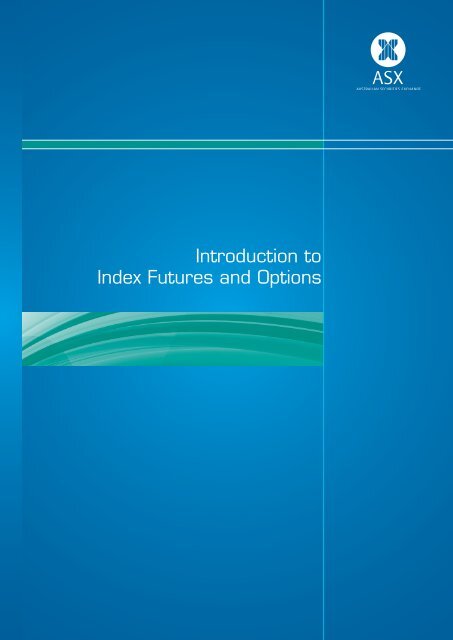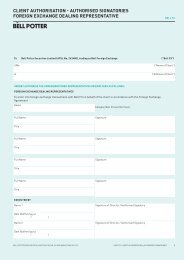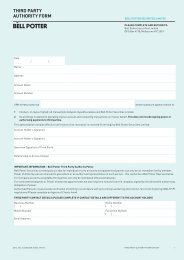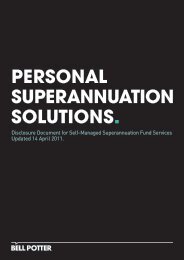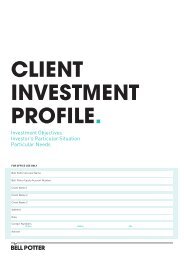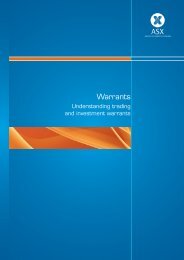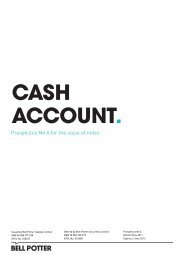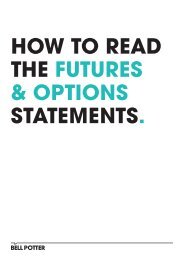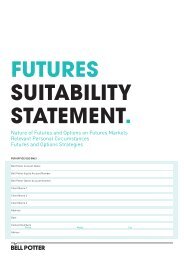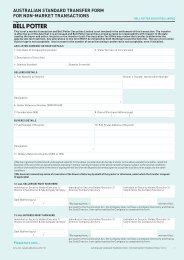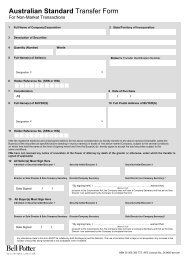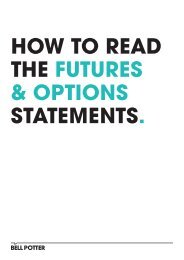Introduction to Index Futures and Options - Bell Potter Securities
Introduction to Index Futures and Options - Bell Potter Securities
Introduction to Index Futures and Options - Bell Potter Securities
You also want an ePaper? Increase the reach of your titles
YUMPU automatically turns print PDFs into web optimized ePapers that Google loves.
<strong>Introduction</strong> <strong>to</strong><br />
<strong>Index</strong> <strong>Futures</strong> <strong>and</strong> <strong>Options</strong>
Disclaimer of Liability<br />
Information provided is for educational purposes <strong>and</strong> does not constitute financial product advice. You<br />
should obtain independent advice from an Australian financial services licensee before making any financial<br />
decisions. Although ASX Limited ABN 98 008 624 691 <strong>and</strong> its related bodies corporate (‘ASX’) has<br />
made every effort <strong>to</strong> ensure the accuracy of the information as at the date of publication, ASX does not<br />
give any warranty or representation as <strong>to</strong> the accuracy, reliability or completeness of the information.<br />
To the extent permitted by law, ASX <strong>and</strong> its employees, officers <strong>and</strong> contrac<strong>to</strong>rs shall not be liable for<br />
any loss or damage arising in any way (including by way of negligence) from or in connection with any<br />
information provided or omitted or from any one acting or refraining <strong>to</strong> act in reliance on this information.<br />
No part of this Booklet may be copied, reproduced, published, s<strong>to</strong>red in a retrieval system or transmitted<br />
in any form or by any means in whole or in part without the prior written permission of the ASX Group.<br />
For these product/s the market is operated by ASX Limited ACN 008 624 691.<br />
All Ordinaries ® , All Ords ® , ASX ® , ASX100 ® *, ASX200*, CHESS ® , <strong>and</strong> ITS ® are trade marks of ASX<br />
Operations Pty Limited, a member of the ASX Group. For those trade marks indicated with an asterisk,<br />
ASXO has entered in<strong>to</strong> an arrangement with St<strong>and</strong>ard & Poor’s (S&P). Those trade marks must be<br />
prefaced by the mark S&P when used <strong>to</strong> describe indices. S&P is a trade mark of St<strong>and</strong>ard & Poor’s,<br />
a division of The McGraw-Hill Companies, Inc.<br />
Edition 11 printed May 2008.<br />
© Copyright 2008 ASX Limited ABN 98 008 624 691. All rights reserved 2008.<br />
Exchange Centre, 20 Bridge Street, Sydney NSW 2000 Telephone: 131 279<br />
www.asx.com.au
Contents<br />
<strong>Introduction</strong> <strong>to</strong> <strong>Index</strong> <strong>Futures</strong> <strong>and</strong> <strong>Options</strong> 2<br />
The Indices 3<br />
<strong>Index</strong> <strong>Futures</strong> 4<br />
<strong>Index</strong> <strong>Options</strong> 10<br />
<strong>Introduction</strong> <strong>to</strong> <strong>Options</strong> Strategies 16<br />
Glossary 19<br />
1
<strong>Introduction</strong> <strong>to</strong> <strong>Index</strong> <strong>Futures</strong> <strong>and</strong> <strong>Options</strong><br />
2<br />
<strong>Index</strong> futures <strong>and</strong> options allow inves<strong>to</strong>rs<br />
exposure <strong>to</strong> movements in a range of<br />
Australian indices or index sec<strong>to</strong>rs in one single<br />
transaction. This allows inves<strong>to</strong>rs <strong>to</strong> invest or<br />
divest in up <strong>to</strong> 200 of Australia’s largest s<strong>to</strong>cks<br />
without the need <strong>to</strong> buy or sell any shares. As<br />
a result, the use of index futures <strong>and</strong> options<br />
provides substantial reductions in transaction<br />
<strong>and</strong> brokerage costs.<br />
Trading futures <strong>and</strong> options also provide the<br />
following benefits:<br />
Leverage: the ability <strong>to</strong> undertake a<br />
comparatively large position for a very small<br />
initial outlay. This concept is similar <strong>to</strong> what is<br />
experienced when you buy a house. Imagine<br />
paying 10% deposit on a house worth<br />
$100,000 <strong>and</strong> borrowing the remainder from<br />
a bank. If the property increases in value by 5%<br />
in one year, the return on your initial investment<br />
of $10,000 is 50% (100,000 x 0.05 =<br />
$5000). <strong>Futures</strong> <strong>and</strong> options provide a similar<br />
form of ‘Leverage’.<br />
Reduced cost of funding: ASX futures <strong>and</strong><br />
options enable a private inves<strong>to</strong>r <strong>to</strong> gain<br />
exposure <strong>to</strong> Australian equities at a fraction<br />
of the cost of traditional investments. This<br />
results in a reduced cost of funding for those<br />
borrowing the money <strong>to</strong> invest.<br />
Making money from both a rising or a falling<br />
market: unlike traditional investment products<br />
which profit only when the market is going<br />
up, with futures <strong>and</strong> options you can also<br />
make money when the market goes down.<br />
Inves<strong>to</strong>rs simply buy a future when the market<br />
is expected <strong>to</strong> rise <strong>and</strong> sell futures when the<br />
market is expected <strong>to</strong> fall. For every point that<br />
the market moves in your favour you gain the<br />
value of the contract size (e.g. AUD25 for ASX<br />
SPI 200 <strong>Index</strong> <strong>Futures</strong> 1 ).<br />
To achieve this in traditional markets may<br />
necessitate the borrowing of s<strong>to</strong>ck, which<br />
incurs considerable cost. As there are no<br />
short selling restrictions in the futures market<br />
these costs <strong>and</strong> additional complications can be<br />
avoided.<br />
Developing trading strategies: futures <strong>and</strong><br />
options provide traders with the flexibility <strong>and</strong><br />
opportunity <strong>to</strong> exploit trends <strong>and</strong> variations<br />
in the marketplace that are not possible<br />
with traditional traded products. By trading<br />
options <strong>and</strong>/or futures, traders can create a<br />
wide range of potentially profitable scenarios<br />
regardless of the direction of the market. Some<br />
of these are discussed later in this document.<br />
Notwithst<strong>and</strong>ing, this increased potential <strong>to</strong><br />
profit may bring with it an increased potential<br />
for loss when trading futures <strong>and</strong> options.<br />
For this reason this document is intended<br />
as a simple introduction <strong>to</strong> the world of<br />
trading futures <strong>and</strong> options. We recommend<br />
all inves<strong>to</strong>rs seek expert advice from an<br />
experienced client adviser prior <strong>to</strong> participating<br />
in these markets.<br />
Flexibility: options are among the most flexible<br />
instruments available. Even in times where<br />
inves<strong>to</strong>rs are uncertain regarding how the<br />
markets will perform, options allow inves<strong>to</strong>rs <strong>to</strong><br />
defer the decision until expiry <strong>to</strong> form a view of<br />
the likely direction of the market.<br />
Limited losses: for buyers of options, losses<br />
are limited <strong>to</strong> the premium paid.<br />
1 index point = $25<br />
Contract Value =<br />
$25 x ASX SPI 200 <br />
<strong>Index</strong> Level<br />
1 Formerly known as SFE SPI 200 <strong>Index</strong> <strong>Futures</strong>.
The Indices<br />
ASX <strong>Index</strong> <strong>Futures</strong> <strong>and</strong> <strong>Options</strong> are based on<br />
the following indices which are maintained by<br />
St<strong>and</strong>ard & Poors:<br />
S&P/ASX 200 <strong>Index</strong><br />
The S&P/ASX 200 index is recognised as<br />
the investable benchmark for the Australian<br />
equity market <strong>and</strong> covers approximately 78%<br />
of Australian equity market capitalisation. It<br />
addresses the needs of investment managers<br />
<strong>to</strong> benchmark against a portfolio characterised<br />
by sufficient size <strong>and</strong> liquidity. The S&P/ASX<br />
200 is comprised of the S&P/ASX 100 plus<br />
an additional 100 s<strong>to</strong>cks.<br />
S&P/ASX 200 A-REIT <strong>Index</strong><br />
The S&P/ASX 200 A-REIT <strong>Index</strong> contains<br />
the listed vehicles classified as Real Estate<br />
Investment Trusts (REITs). REITs own property<br />
<strong>and</strong> derive income from rental returns. A<br />
GICS REITs sec<strong>to</strong>r has been created for the<br />
Australian market, where REITs are treated<br />
almost as a separate asset class <strong>to</strong> equity, <strong>and</strong><br />
are often managed on a separate basis.<br />
S&P/ASX 50 <strong>Index</strong><br />
The S&P/ASX 50 index comprises the 50<br />
largest s<strong>to</strong>cks by market capitalisation in<br />
Australia. The constituent companies represent<br />
the biggest national <strong>and</strong> multi-national publicly<br />
listed companies in the Australian equity<br />
market. The S&P/ASX 50 index places an<br />
emphasis on liquidity <strong>and</strong> investability.<br />
3
<strong>Index</strong> <strong>Futures</strong><br />
4<br />
What is a Future<br />
Broadly, a future is an agreement <strong>to</strong> buy or sell<br />
a particular asset on a specified future date at<br />
a price agreed upon <strong>to</strong>day.<br />
When you buy an index future (go long),<br />
you agree <strong>to</strong> buy the underlying index at a<br />
particular date in the future. Your profit (loss)<br />
is dependent on where the price of the future<br />
is at expiry of the contract or at the time you<br />
close out your position (i.e. buy it back).<br />
When you sell an index future <strong>to</strong> open a<br />
position (go short), you agree <strong>to</strong> sell the index<br />
at a particular date in the future. Your profit<br />
(loss) is dependent on where the futures price<br />
is at expiry or at the level at which you close<br />
out the contract <strong>and</strong> the price at which you<br />
bought the contract.<br />
As explained above, futures are only valid for a<br />
specific term. The term <strong>to</strong> expiry is a common<br />
feature of futures <strong>and</strong> options. Despite this<br />
there are a number of key differences between<br />
index futures <strong>and</strong> index options, including:<br />
• There are no strike (or exercise) prices for<br />
futures. <strong>Futures</strong> transactions are traded<br />
at the market price for the selected expiry<br />
month.<br />
• <strong>Futures</strong> represent an obligation <strong>to</strong> either buy<br />
or sell the underlying rather than just a right<br />
<strong>to</strong> do so.<br />
• <strong>Futures</strong> require an initial margin* for both<br />
buyers <strong>and</strong> sellers which is marked <strong>to</strong><br />
market daily. <strong>Options</strong> require a premium.<br />
<strong>Futures</strong> Pricing<br />
<strong>Futures</strong> contracts generally trade at a premium<br />
<strong>to</strong> the index prior <strong>to</strong> maturity (however it is<br />
possible for futures <strong>to</strong> trade at a discount in<br />
some market conditions). This premium is the<br />
‘cost of carry’. The cost of carry includes the<br />
price of holding the shares over the life of the<br />
contract less the dividends received over the<br />
life of the contract. As expiry approaches, the<br />
futures price tends <strong>to</strong> converge <strong>to</strong> the price of<br />
the index. At expiry the index futures price <strong>and</strong><br />
the index price are equal. This is illustrated in<br />
the diagram below.<br />
Relative Movement of <strong>Index</strong> <strong>Futures</strong> Price<br />
<strong>and</strong> <strong>Index</strong> over Life of Contract<br />
Price/level<br />
<strong>Index</strong> level<br />
Time<br />
<strong>Futures</strong> price<br />
ASX <strong>Index</strong> <strong>Futures</strong> Offering<br />
The ASX offers a variety of index futures<br />
contracts.<br />
– ASX SPI 200 <strong>Index</strong> <strong>Futures</strong><br />
<strong>Futures</strong> maturity<br />
– S&P/ASX 200 A-REIT <strong>Index</strong> <strong>Futures</strong> 1<br />
(commonly referred <strong>to</strong> XPJ <strong>Index</strong> <strong>Futures</strong>)<br />
– S&P/ASX 50 <strong>Index</strong> <strong>Futures</strong> (commonly<br />
referred <strong>to</strong> as XFL <strong>Index</strong> <strong>Futures</strong>)<br />
– S&P/ASX 200 <strong>Index</strong> <strong>Futures</strong> (commonly<br />
referred <strong>to</strong> as XJO <strong>Index</strong> <strong>Futures</strong>)<br />
These are traded on either the ITS or SYCOM<br />
trading platforms on the markets operated by<br />
ASX Ltd <strong>and</strong> SFE Corporation Ltd respectively.<br />
To summarise:<br />
Product Trading Platform market<br />
ASX SPI 200 <strong>Index</strong> <strong>Futures</strong> SYCOM SFE<br />
S&P/ASX 200 A-REIT <strong>Index</strong> <strong>Futures</strong> 1 ITS ASX<br />
S&P/ASX 50 <strong>Index</strong> <strong>Futures</strong> ITS ASX<br />
S&P/ASX 200 <strong>Index</strong> <strong>Futures</strong> ITS ASX<br />
1 Formerly known as ASX Listed Property Trust <strong>Futures</strong>. The name change is consistent with the broader change made by the ASX <strong>and</strong><br />
the Property Council of Australia (PCA) <strong>to</strong> re-br<strong>and</strong> Australian Listed Property Trusts (LPTs) as Australian Real Estate Investment Trusts<br />
(A-REITs), in line with global practice
ASX SPI 200 <strong>Index</strong> <strong>Futures</strong><br />
ASX SPI 200 <strong>Index</strong> <strong>Futures</strong> are the most liquid Australian index futures available <strong>and</strong> are traded<br />
on the SYCOM platform. They are widely used by institutions <strong>and</strong> retail inves<strong>to</strong>rs for a variety of<br />
purposes including directional trading <strong>and</strong> hedging.<br />
Contract Unit<br />
Contract Months<br />
Commodity Code<br />
Valued at A$25 per index point (e.g. A$150,000 at 6,000 index points).<br />
march/June/September/December up <strong>to</strong> six quarter months ahead.<br />
AP<br />
Listing Date 02/05/2000<br />
Minimum Price Movement<br />
Last Trading Day<br />
Cash Settlement Price<br />
one index point (A$25)<br />
All trading in expiring contracts ceases at 12.00pm on the third Thursday of the<br />
settlement month. Non-expiring contracts will continue <strong>to</strong> trade as per the stated<br />
trading hours. 1<br />
The Special Opening Quotation of the underlying S&P/ASX 200 <strong>Index</strong> on the Last<br />
Trading Day. The Special Opening Quotation is calculated using the first traded<br />
price of each component s<strong>to</strong>ck in the S&P/ASX 200 <strong>Index</strong> on the Last Trading Day,<br />
irrespective of when those s<strong>to</strong>cks first trade in the ASX trading day. This means<br />
that the first traded price of each component s<strong>to</strong>ck may occur at any time between<br />
ASX market open <strong>and</strong> ASX market close (including the Closing Single Price Auction)<br />
on the Last Trading Day.<br />
Should any component s<strong>to</strong>ck not have traded by ASX market close on the Last<br />
Trading Day, the last traded price of that s<strong>to</strong>ck will be used <strong>to</strong> calculate the Special<br />
Opening Quotation.<br />
5<br />
Trading Hours 5.10pm – 7.00am <strong>and</strong> 9.50am – 4.30pm 1 (during US daylight saving time) 2<br />
5.10pm – 8.00am <strong>and</strong> 9.50am – 4.30pm 1 (during US non daylight saving time) 2<br />
Settlement Day<br />
Position Limit<br />
Daily Price Limit<br />
CFTC Approved<br />
The first business day after expiry, SFE Clearing publishes the final settlement price<br />
of the contract. On the second business day after expiry, SFE Clearing settles cash<br />
flows as a result of the settlement price.<br />
none<br />
none<br />
Yes<br />
1 Unless otherwise indicated, all times are Sydney times.<br />
2 US daylight saving begins second Sunday in March <strong>and</strong> ends first Sunday in November.
Directional Trading Using ASX SPI<br />
200 <strong>Index</strong> <strong>Futures</strong><br />
Bullish View<br />
How do you profit from a rising share<br />
market using futures<br />
Buy a ASX SPI 200 <strong>Index</strong> <strong>Futures</strong> contract<br />
<strong>and</strong> then sell the contract when the price<br />
has risen. This is also known as going long a<br />
futures contract.<br />
Example<br />
Buy a ASX SPI 200 <strong>Index</strong> <strong>Futures</strong> contract<br />
when the price is 5800 points <strong>and</strong> then sell a<br />
ASX SPI 200 <strong>Index</strong> <strong>Futures</strong> when the price<br />
has risen.<br />
If the ASX SPI 200 <strong>Index</strong> <strong>Futures</strong> contract<br />
price increased by 200 points <strong>to</strong> 6000 points<br />
then the value of your exposure would have<br />
increased <strong>to</strong> $150,000 (ie 6,000 x $25) from<br />
$145,000. In this case you have effectively<br />
made $5,000 or a 50% profit on your initial<br />
margin* outlay of, for example, $10,000. To<br />
realise your gain you simply sell your futures<br />
contract at the higher level.<br />
Example<br />
Sell a ASX SPI 200 <strong>Index</strong> <strong>Futures</strong> contract<br />
when the price is 6,100 points <strong>and</strong> then buy a<br />
ASX SPI 200 <strong>Index</strong> <strong>Futures</strong> contract when the<br />
price has fallen.<br />
By paying your broker an initial margin* of,<br />
for example, $10,000 you can sell a ASX SPI<br />
200 <strong>Index</strong> <strong>Futures</strong> contract. Unlike when you<br />
bought the futures contract, this time you make<br />
a profit if the market falls. If the ASX SPI 200 <br />
<strong>Index</strong> <strong>Futures</strong> price decreases by 250 points<br />
<strong>to</strong> 5,850 points you are able <strong>to</strong> close out your<br />
futures contract by buying at the lower level.<br />
If you originally sold the contract at 6100 <strong>and</strong><br />
bought at 5850 you would have made a profit<br />
equal <strong>to</strong> $6,250 (ie 250 x $25) or a 62.5%<br />
profit on your initial margin* of $10,000.<br />
Profit from a Falling Market<br />
Profit Diagram at expiry if you sell one<br />
ASX SPI 200 <strong>Index</strong> <strong>Futures</strong> at 6100 points<br />
$6250<br />
6<br />
Profit from a Rising Market<br />
Profit Diagram at expiry if you buy one<br />
ASX SPI 200 <strong>Index</strong> <strong>Futures</strong> at 5800 points<br />
$0<br />
5850 6100 6350<br />
ASX SPI 200<br />
<strong>Index</strong> <strong>Futures</strong> Price<br />
$5000<br />
$-6250<br />
$0<br />
$-5000<br />
Bearish View<br />
5600 5800 6000<br />
ASX SPI 200<br />
<strong>Index</strong> <strong>Futures</strong> Price<br />
Using futures <strong>to</strong> protect the value<br />
of your portfolio (hedging)<br />
If you own a portfolio of s<strong>to</strong>ck that broadly<br />
tracks the index <strong>and</strong> believe that the market is<br />
going <strong>to</strong> fall but do not want <strong>to</strong> sell (for either<br />
cost or tax reasons) you can safeguard the<br />
value of your portfolio by selling ASX SPI 200 <br />
<strong>Index</strong> <strong>Futures</strong>. This act of protecting your<br />
portfolio is known as hedging.<br />
How do you profit from a falling share<br />
market<br />
Sell a ASX SPI 200 <strong>Index</strong> <strong>Futures</strong> contract<br />
<strong>and</strong> then buy the contract when the price has<br />
fallen. This is also known as going short a<br />
futures contract.<br />
When you implement a hedging strategy using<br />
futures any decrease (increase) in the value of<br />
your sharemarket portfolio will be compensated<br />
for by an increase (decrease) in the value of the<br />
futures contract.
Why hedge<br />
• To reduce your exposure <strong>to</strong> the market<br />
without incurring the transaction costs of<br />
selling your entire portfolio of s<strong>to</strong>ck.<br />
• To lock in a buying <strong>and</strong> selling price for your<br />
s<strong>to</strong>ck market portfolio.<br />
• To lock in a particular return for an equity<br />
portfolio (eg a trader may have achieved their<br />
target return for a period <strong>and</strong> they want <strong>to</strong><br />
lock this in. By trading a futures contract they<br />
do not have <strong>to</strong> sell their shares).<br />
How do you protect your portfolio<br />
Sell ASX SPI 200 <strong>Index</strong> <strong>Futures</strong>. By selling an<br />
ASX SPI 200 <strong>Index</strong> <strong>Futures</strong> contract you can<br />
lock in the value of your portfolio for the life of<br />
the futures contract.<br />
Example<br />
Assume you hold a portfolio that approximately<br />
tracks the S&P/ASX 200 <strong>Index</strong> worth<br />
$280,000 <strong>and</strong> that the current index level is<br />
6000 points. You expect that the market will<br />
drop by approximately 5% within the month.<br />
To avoid this you could sell your portfolio <strong>and</strong><br />
re-enter the market when you have more<br />
confidence that the market will continue <strong>to</strong><br />
rise. By doing this you would incur significant<br />
transaction costs, both on the sale <strong>and</strong> the repurchase<br />
of the portfolio.<br />
The alternative is <strong>to</strong> sell futures. Not only are<br />
futures transaction costs lower than those<br />
associated with portfolio liquidation, but the<br />
selling process is faster. Another benefit of<br />
using futures is that the original portfolio is<br />
maintained.<br />
The first step is <strong>to</strong> determine how many<br />
futures contracts will be required <strong>to</strong> hedge the<br />
portfolio.<br />
With the ASX SPI 200 <strong>Index</strong> <strong>Futures</strong> price<br />
at 6000 points 1 , one futures contract is<br />
worth $150,000 (6000 points x $25). To<br />
determine the number of contracts that will<br />
be required, divide the value of the portfolio by<br />
the face value of the futures contract, which<br />
in this case is $280,000/$150,000 = 1.87.<br />
Rounding up <strong>to</strong> the nearest whole number, two<br />
futures contracts will be required <strong>to</strong> provide an<br />
adequate hedge for this portfolio. The inves<strong>to</strong>r<br />
should therefore sell two ASX SPI 200 <strong>Index</strong><br />
<strong>Futures</strong> contracts <strong>to</strong> hedge this portfolio.<br />
Assume that your prediction turned out <strong>to</strong> be<br />
correct <strong>and</strong> your market portfolio dropped by<br />
5% <strong>and</strong> lost $14,000 <strong>and</strong> that the futures<br />
price fell by 300 points <strong>to</strong> 5700 points. At this<br />
time you could choose <strong>to</strong> close out the position<br />
by buying back the two futures contracts.<br />
7<br />
Period <strong>Index</strong> Level S<strong>to</strong>ck Position <strong>Futures</strong> Position<br />
Day 1 6000 $280,000 Sell <strong>Futures</strong>: Number of futures = S<strong>to</strong>ck<br />
portfolio value/Face Value of <strong>Futures</strong><br />
Contract = $280,000/(6000 x $25)<br />
=1.87 = 2 <strong>Futures</strong> contracts (rounded<br />
<strong>to</strong> the nearest whole digit)<br />
Position Value $300,000<br />
Day 30 <strong>Index</strong> Level drops S<strong>to</strong>ck Portfolio value Buy back futures Notional Value at 5700<br />
5% <strong>to</strong> 5700 falls 5% <strong>to</strong> $266,000 <strong>Index</strong> Level = 5700 x $25x 2<br />
Position Value ($285,000)<br />
GAIN -$14,000 $15,000<br />
NET GAIN $1,000<br />
Since you sold the futures contract at 6000 points <strong>and</strong> you bought at 5700, the profit on the<br />
futures transaction is $15,000 (ie 300 points x $25 x 2).<br />
Accordingly, even though the market <strong>and</strong> value of the portfolio declined $14,000, the short<br />
futures position increased in value by $15,000, offsetting the equity loss.<br />
1<br />
In this example, the futures price equals the index level. In reality, the <strong>Index</strong> <strong>Futures</strong> may be trading at a discount or premium before expiry.
XPJ <strong>Index</strong> <strong>Futures</strong><br />
The Australian Real Estate Investment Trust sec<strong>to</strong>r has been growing strongly in recent years.<br />
The XPJ <strong>Index</strong> <strong>Futures</strong> contract is a small sized contract with a AUD10 contract value. XPJ<br />
<strong>Index</strong> <strong>Futures</strong> were listed on ASX in August 2002 <strong>to</strong> provide the market with an effective, liquid<br />
derivative product <strong>to</strong> manage exposure <strong>to</strong> the A-REIT sec<strong>to</strong>r. XPJ <strong>Index</strong> <strong>Futures</strong> are traded on the<br />
ITS platform.<br />
ASX A-REIT <strong>Futures</strong> provide the following benefits for inves<strong>to</strong>rs:<br />
• Exposure: One transaction provides exposure <strong>to</strong> every A-REIT in the S&P/ASX 200 <strong>Index</strong>.<br />
• Reduce Trading Costs: By accessing the entire sec<strong>to</strong>r with one transaction, inves<strong>to</strong>rs save on<br />
transaction fees. Also, inves<strong>to</strong>rs are able <strong>to</strong> use shares as collateral <strong>to</strong> cover initial margins*.<br />
Interest paid on cash lodged with ASX’s Clearing House <strong>to</strong> cover initial margins*.<br />
8<br />
Name<br />
Underlying index<br />
Contract code<br />
Contract multiplier<br />
Quotation/ Tick size<br />
Contract months<br />
Expiry Day<br />
Last trading day<br />
Trading hours<br />
Cash settlement<br />
Settlement method<br />
Initial margin<br />
Daily variation margin<br />
Margin cover<br />
XPJ <strong>Index</strong> <strong>Futures</strong>.<br />
S&P/ASX 200 A-REIT <strong>Index</strong>.<br />
The futures contract code is a five character code. The first three letters are the<br />
ASX code of the underlying index, XPJ. The fourth character is a number designating<br />
the year of maturity <strong>and</strong> the fifth character represents the maturity month.<br />
Valued at AUD $10 per index point.<br />
Prices quoted as the number of points, with a minimum price movement of 1 index<br />
point = AUD $10.<br />
march, June, September, December up <strong>to</strong> four quarter months ahead<br />
The third Thursday of the contract month, unless otherwise specified by ASX.<br />
Trading will cease at 12 noon on expiry Thursday.<br />
6.00am <strong>to</strong> 5.00pm <strong>and</strong> 5.30pm <strong>to</strong> 8.00pm (Sydney time)<br />
Cash settlement is based on the opening prices of the s<strong>to</strong>cks in the Underlying <strong>Index</strong><br />
on expiry morning. An index calculation (the Opening Price <strong>Index</strong> Calculation (OPIC))<br />
is made using these opening prices. This means trading will continue after the<br />
settlement price has been determined.<br />
The cash settlement amount is calculated by the calculation agent (St<strong>and</strong>ard &<br />
Poors) <strong>and</strong> forwarded <strong>to</strong> ACH. The settlement amount is then paid or received net of<br />
margins on the next business day.<br />
Initial margins for both buyers <strong>and</strong> sellers are determined by ACH according <strong>to</strong> the<br />
volatility of the underlying index <strong>and</strong> are reviewed regularly.<br />
<strong>Futures</strong> positions for both buyers <strong>and</strong> sellers are settled <strong>to</strong> market each day <strong>and</strong><br />
subject <strong>to</strong> variation margins. An intra-day margin call may also be made by ACH.<br />
Settlement <strong>to</strong> market margin obligations must be settled daily by the payment of<br />
cash. Initial margins can be cash or collateral covered.
ASX <strong>Index</strong> <strong>Futures</strong><br />
ASX <strong>Index</strong> <strong>Futures</strong> are small sized futures contracts. Like the XPJ <strong>Index</strong> <strong>Futures</strong> contract<br />
they have a contract size of AUD10. The contracts are offered over the S&P/ASX 50 <strong>Index</strong><br />
(commonly referred <strong>to</strong> as XFL <strong>Index</strong> <strong>Futures</strong>) <strong>and</strong> the S&P/ASX 200 <strong>Index</strong> (commonly referred <strong>to</strong><br />
as XJO <strong>Index</strong> <strong>Futures</strong>). This product offering allows inves<strong>to</strong>rs <strong>to</strong> tailor their exposure <strong>to</strong> either the<br />
leading s<strong>to</strong>cks (S&P/ASX 50) or the broad sharemarket (S&P/ASX 200).<br />
ASX <strong>Index</strong> <strong>Futures</strong> are traded on the ITS platform.<br />
The benefits accruing <strong>to</strong> inves<strong>to</strong>rs in ASX <strong>Index</strong> <strong>Futures</strong> include:<br />
• Reduced Trading Costs – inves<strong>to</strong>rs in ASX <strong>Index</strong> <strong>Futures</strong> may reduce their trading costs by:<br />
– lodging shares as collateral <strong>to</strong> cover initial margins*<br />
– interest accrued on any cash lodged with ASX clearing house <strong>to</strong> cover initial margins*.<br />
• Trade Across Different Markets – when trading ASX <strong>Index</strong> <strong>Futures</strong> inves<strong>to</strong>rs may trade across<br />
any number of ASX markets including exchange traded options, XPJ <strong>Index</strong> <strong>Futures</strong>, LEPOs <strong>and</strong><br />
s<strong>to</strong>cks with ease as they are on the same trading platform, ITS.<br />
Name<br />
Underlying index<br />
Contract code<br />
Contract multiplier<br />
Quotation/ Tick size<br />
Contract months<br />
Expiry Day<br />
Last trading day<br />
Trading hours<br />
Cash settlement<br />
Settlement method<br />
Initial margin<br />
Daily variation margin<br />
Margin cover<br />
ASX <strong>Index</strong> <strong>Futures</strong><br />
Contracts are over the S&P/ASX 200 <strong>Index</strong> <strong>and</strong> the S&P/ASX 50 <strong>Index</strong><br />
The futures contract code is a five character code. The first three letters are the<br />
ASX code of the underlying index. The fourth character is a number designating the<br />
year of maturity <strong>and</strong> the fifth character represents the maturity month.<br />
Valued at AUD $10 per index point.<br />
Prices quoted as the number of points, with a minimum price movement of 1 index<br />
point = AUD $10.<br />
March, June, September <strong>and</strong> December up <strong>to</strong> four quarter months ahead (XFL <strong>Index</strong><br />
<strong>Futures</strong>).<br />
March, June, September <strong>and</strong> December up <strong>to</strong> six quarter months ahead with serial<br />
contracts up <strong>to</strong> two non-financial quarter months ahead (XJO <strong>Index</strong> <strong>Futures</strong>).<br />
The third Thursday of the contract month, unless otherwise specified by ASX.<br />
Trading will cease at 12 noon on expiry Thursday.<br />
6.00am <strong>to</strong> 5.00pm <strong>and</strong> 5.30pm <strong>to</strong> 8.00pm (Sydney time)<br />
Cash settlement is based on the opening prices of the s<strong>to</strong>cks in the Underlying <strong>Index</strong><br />
on expiry morning. An index calculation (the Opening Price <strong>Index</strong> Calculation (OPIC))<br />
is made using these opening prices. This means trading will continue after the<br />
settlement price has been determined.<br />
The cash settlement amount is calculated by the calculation agent (St<strong>and</strong>ard &<br />
Poors) <strong>and</strong> forwarded <strong>to</strong> ACH. The settlement amount is then paid or received net of<br />
margins on the next business day.<br />
Initial margins for both buyers <strong>and</strong> sellers are determined by ACH according <strong>to</strong> the<br />
volatility of the underlying index <strong>and</strong> are reviewed regularly.<br />
<strong>Futures</strong> positions for both buyers <strong>and</strong> sellers are settled <strong>to</strong> market each day <strong>and</strong><br />
subject <strong>to</strong> variation margins. An intra-day margin call may also be made by ACH.<br />
Settlement <strong>to</strong> market margin obligations must be settled daily by the payment of<br />
cash. Initial margins can be cash or collateral covered.<br />
9<br />
Settlement<br />
All ASX <strong>Futures</strong> are settled using the Opening Price <strong>Index</strong> Calculation (OPIC). The settlement price<br />
is calculated using the first traded price of each s<strong>to</strong>ck comprising the index. This method is widely<br />
used <strong>to</strong> settle index futures contracts internationally including contracts over the S&P 500 <strong>and</strong><br />
Dow Jones Industrial Indices in the United States <strong>and</strong> the Nikkei 225 <strong>and</strong> Nikkei 300 in Japan.<br />
The wide acceptance of the OPIC method is credited <strong>to</strong> the effective management of volatility that<br />
generally occurs at maturity of index futures contracts.
<strong>Index</strong> <strong>Options</strong><br />
10<br />
What is an <strong>Index</strong> Option<br />
An index option is a contract between two<br />
parties which gives the buyer the right but<br />
not the obligation <strong>to</strong> buy or sell a specified<br />
index value at a specified price on or before a<br />
specified date.<br />
There are two types of options: call options <strong>and</strong><br />
put options. Call options give writers the right<br />
but not the obligation <strong>to</strong> buy the index value<br />
while put options give buyers the right but not<br />
the obligation <strong>to</strong> sell the index value.<br />
At the time of the options transaction, the<br />
option buyer pays the options seller a premium.<br />
The premium is the cost of the option.<br />
The act of converting the option in<strong>to</strong> the cash<br />
return/loss or the underlying futures contract<br />
is referred <strong>to</strong> as exercise. The Exercise Price<br />
(also called Strike Price) is the price at which<br />
an option taker has the right <strong>to</strong> buy (in the<br />
case of a call option) or sell (in the case of a<br />
put option) the underlying index or contract.<br />
<strong>Options</strong> are listed with multiple exercise prices.<br />
Terms for describing options<br />
In-the-Money<br />
A call option is in-the-money when the<br />
underlying price is greater than the exercise<br />
price. A put option is in-the-money when the<br />
exercise price of the option is greater than the<br />
price of the underlying.<br />
<strong>Options</strong> that are in-the-money have ‘intrinsic<br />
value’ equalling the difference between the<br />
exercise price of the option <strong>and</strong> the market<br />
price of the underlying futures price.<br />
At-the-Money<br />
An option where the underlying price equals the<br />
exercise price.<br />
Out-of-the-Money<br />
A call option is out-of-the-money if the exercise<br />
price is greater than the underlying price. A put<br />
option is out-of-the-money if the underlying price<br />
is greater than the strike price.<br />
The buyer of the option is not obliged <strong>to</strong><br />
exercise the option. The buyer may sell the<br />
option before expiry. Alternatively, the buyer<br />
may allow the contract <strong>to</strong> lapse at expiry.<br />
<strong>Options</strong> Pricing<br />
Premium<br />
The premium of an option is the sum of the<br />
intrinsic value <strong>and</strong> time value of that option.<br />
This is illustrated below.<br />
Intrinsic Value<br />
The extent <strong>to</strong> which an option is in the money<br />
is its intrinsic value. The intrinsic value is<br />
calculated as follows:<br />
For a Call Option:<br />
max (<strong>Index</strong> Price-Strike Price,0)<br />
For a Put Option:<br />
max (Strike Price-<strong>Index</strong> Price,0)<br />
An illustration of the intrinsic value for a call<br />
option is shown below.<br />
Strike <strong>Index</strong> Price Intrinsic Value<br />
Call Option (In-the-money) 6000 6050 = max(6050-6000,0)=50<br />
Call Option (At-the-money) 6000 6000 = max(6000-6000,0)=0<br />
Call Option (Out-of-the-money) 6000 5950 = max(5950-6000,0)=0<br />
Strike <strong>Index</strong> Price Intrinsic Value<br />
Put Option (Out-of-the-money) 6000 6050 = max(6000-6050,0)=0<br />
Put Option (At-the-money) 6000 6000 = max(6000-6000,0)=0<br />
Put Option (In-the-money) 6000 5950 = max(6000-5950,0)=50
Time Value<br />
An option with a long period of time remaining<br />
until expiration comm<strong>and</strong>s a higher premium<br />
than an option with a short time <strong>to</strong> expiry<br />
because it has more time in which <strong>to</strong> become<br />
profitable. Time value is determined by<br />
subtracting intrinsic value from the option<br />
premium. (ie Time value = option premium -<br />
intrinsic value).<br />
Volatility<br />
The greater the volatility of the underlying<br />
market/futures contract, the higher the<br />
premium. In a volatile market, the option<br />
st<strong>and</strong>s a greater chance of becoming profitable<br />
<strong>to</strong> exercise over the life of the option.<br />
ASX <strong>Index</strong> <strong>Options</strong> Product Offering<br />
ASX offers a variety of index options traded on<br />
both the SYCOM <strong>and</strong> ITS platforms on markets<br />
operated by ASX Ltd <strong>and</strong> SFE Corporation Ltd<br />
respectively. These include:<br />
• S&P/ASX 200 <strong>Index</strong> <strong>Options</strong> (commonly<br />
referred <strong>to</strong> as XJO <strong>Index</strong> <strong>Options</strong>)<br />
• ASX SPI 200 <strong>Index</strong> <strong>Options</strong> 1<br />
• S&P/ASX 200 A-REIT <strong>Index</strong> <strong>Options</strong><br />
(commonly referred <strong>to</strong> as the XPJ <strong>Index</strong><br />
<strong>Options</strong>)<br />
• S&P/ASX 50 <strong>Index</strong> <strong>Options</strong><br />
(commonly referred <strong>to</strong> as the XFL <strong>Index</strong><br />
<strong>Options</strong>)<br />
XJO <strong>Index</strong> <strong>Options</strong><br />
XJO <strong>Index</strong> <strong>Options</strong> are the trading vehicle<br />
of choice for many retail <strong>and</strong> institutional<br />
inves<strong>to</strong>rs. This option is listed directly over the<br />
S&P/ASX 200 <strong>Index</strong> <strong>and</strong> has a contract size of<br />
AUD10. XJO <strong>Index</strong> <strong>Options</strong> are European style.<br />
Only ‘in-the-money’ options are au<strong>to</strong>matically<br />
exercised at expiry. ‘At-the-money’ options will<br />
have <strong>to</strong> be manually exercised.<br />
Name<br />
Underlying <strong>Index</strong><br />
Security Codes<br />
XJO <strong>Index</strong> <strong>Options</strong><br />
S&P/ASX 200 <strong>Index</strong><br />
XJO<br />
11<br />
<strong>Index</strong> Multiplier $10. Each index point is equal <strong>to</strong> AUD $10.<br />
Tick Size<br />
Exercise Style<br />
Exercise Intervals<br />
Type<br />
Contract Months<br />
Expiry Day<br />
Last Trading Day<br />
Trading Hours<br />
Settlement<br />
Settlement Day<br />
Quoted as the number of points of the index. (Tick size 1.0 point)<br />
European, ie. exercisable only on expiry day.<br />
25 <strong>Index</strong> points<br />
Call <strong>and</strong> put options<br />
march, June, September, December up <strong>to</strong> six quarter months ahead <strong>and</strong> serial<br />
months up <strong>to</strong> two non-financial quarter months ahead<br />
The third Thursday of the contract month, unless otherwise specified by ASX.<br />
Trading will cease at 12 noon on expiry Thursday.<br />
6.00am <strong>to</strong> 5.00pm <strong>and</strong> 5.30pm <strong>to</strong> 8.00pm (Sydney time)<br />
<strong>Index</strong> options are cash settled using the opening price index calculation on expiry<br />
morning. This means trading will continue after the settlement price has been<br />
determined.<br />
The first business day following the Last Trading Day<br />
1 Formerly known as SFE SPI 200 <strong>Index</strong> <strong>Options</strong>.
12<br />
Speculate<br />
You can use index options <strong>to</strong> profit from the<br />
movement in the index per se even if you do<br />
not hold an underlying portfolio. <strong>Options</strong> provide<br />
exposure <strong>to</strong> movements in the index without<br />
having <strong>to</strong> buy each s<strong>to</strong>ck in the index in the<br />
same proportions. Because of the small initial<br />
outlay, you gain leveraged exposure <strong>to</strong> index<br />
movements.<br />
Bullish View<br />
How do you Profit from a Rising Market<br />
Buy an XJO <strong>Index</strong> Call Option.<br />
Example<br />
Buy a 5800 XJO <strong>Index</strong> Call Option for a price of<br />
15 points.<br />
By paying your broker a premium of $150 (ie<br />
15 points x $10) you have bought the right <strong>to</strong><br />
buy the index if the index value is greater than<br />
5800 before the option expires. The diagram<br />
below shows the potential profit or loss on<br />
the strategy for different index levels at expiry.<br />
Since you paid $150 for the option you will<br />
need the index value <strong>to</strong> be above the breakeven<br />
point of 5815 <strong>to</strong> make a profit on the<br />
option. The diagram shows that while the index<br />
is below 5815 points the call option buyer<br />
would make a loss. The most the call option<br />
buyer can lose is the price of the option, worth<br />
$150.<br />
The maximum profit <strong>to</strong> the buyer is unlimited.<br />
If by the expiry date the index had risen <strong>to</strong><br />
5980 points, then your profit would be $1,650<br />
($1,800 - $150).<br />
Bearish View<br />
How do you Profit from a Falling Market<br />
Buy a XJO <strong>Index</strong> Put Option.<br />
Example<br />
Buy a 6000 XJO <strong>Index</strong> Put Option for a price of<br />
16 points.<br />
By paying your broker the premium of $160<br />
(ie 16 points x $10) you have bought the right<br />
<strong>to</strong> sell the index for 6000 points before the<br />
option expires.<br />
The diagram below shows the potential profit<br />
or loss on the strategy for different index levels<br />
at expiry. Since you paid $160 for the option<br />
you will need the index level <strong>to</strong> be below the<br />
break-even point of 5984 <strong>to</strong> make a profit<br />
on the option. The diagram shows that while<br />
the index is above 5984 points the put option<br />
buyer would make a loss. The most the put<br />
option buyer can lose is the price of the option,<br />
worth $160.<br />
The maximum profit <strong>to</strong> the buyer is limited<br />
because the minimum index level is 0. If by the<br />
expiry date the index had fallen <strong>to</strong> 5860 points,<br />
then your profit would be $1240 ($1400 –<br />
$160).<br />
Profit from a Falling Market<br />
Profit Diagram at expiry if you buy a 6000 Put Option<br />
One <strong>Index</strong> Point = $10<br />
$1240<br />
Profit from a Rising Market<br />
Profit Diagram at expiry if you buy a 5800 Call Option<br />
One <strong>Index</strong> Point = $10<br />
$0<br />
$-160<br />
5860 6000 6140<br />
Break even<br />
point = 5984<br />
<strong>Index</strong> Level<br />
$1650<br />
$0<br />
$-150<br />
<strong>Index</strong> Level<br />
5600 5800 5980<br />
Break even<br />
point = 5815
Hedge<br />
If you hold a s<strong>to</strong>ck portfolio <strong>and</strong> are concerned<br />
about a short term fall in value, put options<br />
allow you <strong>to</strong> protect your portfolio against a<br />
market downturn. Buying a put option will lock<br />
in the value of your portfolio no matter how<br />
low it falls. Even if the market downturn you<br />
predicted does not come <strong>to</strong> pass, you have no<br />
obligation <strong>to</strong> exercise, rather you benefit from<br />
the increase in your portfolio <strong>and</strong> your loss is<br />
limited <strong>to</strong> the premium paid.<br />
How do you protect a s<strong>to</strong>ck portfolio<br />
position<br />
Buy put options. During a market fall the<br />
increase in the price of the put option will<br />
counter the fall in the value of the s<strong>to</strong>ck<br />
portfolio.<br />
Example<br />
You hold a share portfolio of blue chip s<strong>to</strong>cks<br />
that broadly track the index. The index is<br />
currently at 6000 points. You want <strong>to</strong> protect<br />
your portfolio from a fall in the index. You could<br />
place a ‘S<strong>to</strong>p Loss’ order with your broker,<br />
but that could result in you being ‘closed-out’<br />
in some of your s<strong>to</strong>cks just before the market<br />
rallies. An alternative is <strong>to</strong> buy a 6000 put<br />
option. This allows you <strong>to</strong> lock in the value<br />
of the index. The short writer of the put will<br />
pay you for the difference between the 6000<br />
point index level <strong>and</strong> where the market falls<br />
<strong>to</strong>. The profit on your options position would<br />
compensate you for any loss on your s<strong>to</strong>ck<br />
portfolio until the option expiry date.<br />
Earn Income<br />
Writing (selling) index call options against a<br />
portfolio position (that broadly resembles the<br />
index) allows inves<strong>to</strong>rs <strong>to</strong> earn income over<br />
<strong>and</strong> above the dividends received. This is a<br />
popular strategy with inves<strong>to</strong>rs who expect<br />
the price of the index <strong>to</strong> remain flat or fall<br />
slightly. Notwithst<strong>and</strong>ing, selling options carries<br />
substantial risk if you do not have an underlying<br />
s<strong>to</strong>ck portfolio position <strong>to</strong> cover the option.<br />
Opportunistic View<br />
How do you earn extra income by selling<br />
options<br />
Sell options against an existing portfolio of<br />
s<strong>to</strong>cks. These are known as ‘covered options’.<br />
Example<br />
Assume you hold a s<strong>to</strong>ck portfolio that broadly<br />
tracks the index. The index is currently at 5900<br />
points <strong>and</strong> you expect the index <strong>to</strong> remain<br />
relatively flat over the next three months<br />
<strong>and</strong> would like <strong>to</strong> earn some income in that<br />
time. You find out that XJO <strong>Index</strong> Call <strong>Options</strong><br />
with an exercise price of 6000 expiring in 3<br />
months are worth around 32 points. As you<br />
do not expect the index <strong>to</strong> rise above 6000<br />
points before expiry, you instruct your broker<br />
<strong>to</strong> sell one of these options. You receive $320<br />
premium.<br />
If the market stayed neutral as expected, then<br />
you keep the premium of $320 ($10 x 32<br />
points).<br />
ASX SPI 200 <strong>Index</strong> Option<br />
This product is listed over the ASX SPI 200 <br />
<strong>Index</strong> Future. The ASX SPI 200 <strong>Index</strong> Option<br />
has a contract size of AUD25.<br />
ASX SPI 200 <strong>Index</strong> <strong>Options</strong> are American<br />
style <strong>and</strong> may therefore be exercised on any<br />
business day up <strong>to</strong> <strong>and</strong> including the Last<br />
Trading Day (expiry day). Only ‘in-the-money’<br />
options are au<strong>to</strong>matically exercised at expiry.<br />
Note that generally traders do not exercise<br />
their options but sell them <strong>to</strong> realise their gain<br />
or loss.<br />
The ASX SPI 200 <strong>Index</strong> <strong>Options</strong> are available<br />
<strong>to</strong> be traded on the SYCOM platform.<br />
Unlike the index options mentioned above,<br />
where the seller received the premium when<br />
the contract is struck, the seller of ASX XJO<br />
<strong>Index</strong> <strong>Options</strong> receives the option premium<br />
during the life of the contract. This transaction<br />
occurs via the margining process*. A futures<br />
style margining methodology* is applied <strong>to</strong> ASX<br />
SPI 200 <strong>Index</strong> <strong>Options</strong> positions <strong>and</strong> there<br />
is a daily mark-<strong>to</strong>-market over the life of the<br />
option.<br />
13
ASX SPI 200 <strong>Index</strong> <strong>Options</strong><br />
Contract Unit<br />
Contract Months<br />
Commodity Code<br />
Valued at A$25 per index point (e.g. A$150,000 at 6,000 index points).<br />
ASX SPI 200 1 index options expire in the same calendar month as the underlying ASX<br />
SPI 200 1 index futures contract. Put <strong>and</strong> Call options available on existing ASX SPI<br />
200 1 index futures contracts.<br />
ASX SPI 200 1 <strong>Index</strong> <strong>Options</strong> available four quarter months ahead.<br />
AP<br />
Listing Date 02/05/2000<br />
Minimum Price Movement<br />
Exercise Prices<br />
Last Trading Day<br />
Cash Settlement Price<br />
0.5 index points (A$12.50)<br />
Set at intervals of 25 index points. New option exercise prices created au<strong>to</strong>matically as<br />
the underlying futures contract price fluctuates.<br />
The last day of trading of the underlying futures contract.<br />
All trading in expiring contracts ceases at 12.00pm on the Last Trading Day.<br />
Non-expiring contracts will continue <strong>to</strong> trade as per the stated trading hours. 2<br />
The Cash Settlement Price of the underlying futures contract.<br />
Trading Hours 5.10pm – 7.00am <strong>and</strong> 9.50am – 4.30pm 2 (during US daylight saving time) 3<br />
5.10pm – 8.00am <strong>and</strong> 9.50am – 4.30pm 2 (during US non daylight saving time) 3<br />
Settlement Day<br />
Position Limit<br />
Daily Price Limit<br />
options may be exercised on any business day up <strong>to</strong> <strong>and</strong> including the Last Trading Day.<br />
Only ‘in-the-money’ options are au<strong>to</strong>matically exercised at expiry, unless ab<strong>and</strong>oned. Upon<br />
exercise, the holder will receive an underlying ASX SPI 200 1 index futures contract<br />
position at the option strike price.<br />
none<br />
none<br />
14<br />
CFTC Approved<br />
Yes<br />
1 ASX SPI 200 is a trademark of the Sydney <strong>Futures</strong> Exchange<br />
2 Unless otherwise indicated, all times are Sydney times.<br />
3 US daylight saving begins second Sunday in March <strong>and</strong> ends first Sunday in November.<br />
XPJ <strong>Index</strong> <strong>Options</strong><br />
The XPJ <strong>Index</strong> <strong>Options</strong> are listed over the S&P/ASX 200 A-REIT <strong>Index</strong>. XPJ <strong>Index</strong> <strong>Options</strong> are<br />
European style. They have a contract size of AUD10 <strong>and</strong> are traded on the ITS platform. Only ‘in-themoney’<br />
options are au<strong>to</strong>matically exercised at expiry. ‘At-the-money’ options will have <strong>to</strong> be manually<br />
exercised. This product is available <strong>to</strong> be traded on the ITS platform.<br />
Name<br />
Underlying <strong>Index</strong><br />
Security Codes<br />
XPJ <strong>Index</strong> <strong>Options</strong><br />
S&P/ASX 200 A-REIT <strong>Index</strong><br />
XPJ<br />
<strong>Index</strong> Multiplier $10. Each index point is equal <strong>to</strong> AUD $10.<br />
Tick Size<br />
Exercise Style<br />
Exercise Intervals<br />
Type<br />
Contract Months<br />
Expiry Day<br />
Last Trading Day<br />
Trading Hours<br />
Settlement<br />
Settlement Day<br />
Quoted as the number of points of the index. (Tick size 1.0 point)<br />
European, ie. exercisable only on expiry day.<br />
25 <strong>Index</strong> points<br />
Call <strong>and</strong> put options<br />
march, June, September, December up <strong>to</strong> four quarter months ahead<br />
The third Thursday of the contract month, unless otherwise specified by ASX.<br />
Trading will cease at 12 noon on expiry Thursday.<br />
6.00am <strong>to</strong> 5.00pm <strong>and</strong> 5.30pm <strong>to</strong> 8.00pm (Sydney time)<br />
<strong>Index</strong> options are cash settled using the opening price index calculation on expiry morning.<br />
This means trading will continue after the settlement price has been determined.<br />
The first business day following the Last Trading Day
XFL <strong>Index</strong> <strong>Options</strong><br />
XFL <strong>Index</strong> <strong>Options</strong> are also AUD10 contract size. XFL <strong>Index</strong> <strong>Options</strong> are European style. Only<br />
‘in-the-money’ options are au<strong>to</strong>matically exercised at expiry. ‘At-the-money’ options will have <strong>to</strong> be<br />
manually exercised.This product is available <strong>to</strong> be traded on the ITS platform.<br />
Name<br />
Underlying <strong>Index</strong><br />
Security Codes<br />
XFL <strong>Index</strong> <strong>Options</strong><br />
S&P/ASX 50 <strong>Index</strong><br />
XFL<br />
<strong>Index</strong> Multiplier $10. Each index point is equal <strong>to</strong> AUD $10.<br />
Tick Size<br />
Exercise Style<br />
Exercise Intervals<br />
Type<br />
Contract Months<br />
Expiry Day<br />
Last Trading Day<br />
Trading Hours<br />
Settlement<br />
Settlement Day<br />
Quoted as the number of points of the index. (Tick size 1.0 point)<br />
European, ie. exercisable only on expiry day.<br />
25 <strong>Index</strong> points<br />
Call <strong>and</strong> put options<br />
march, June, September, December up <strong>to</strong> four quarter months ahead<br />
The third Thursday of the contract month, unless otherwise specified by ASX.<br />
Trading will cease at 12 noon on expiry Thursday.<br />
6.00am <strong>to</strong> 5.00pm <strong>and</strong> 5.30pm <strong>to</strong> 8.00pm (Sydney time)<br />
<strong>Index</strong> options are cash settled using the opening price index calculation on expiry<br />
morning. This means trading will continue after the settlement price has been<br />
determined.<br />
The first business day following the Last Trading Day<br />
15
<strong>Introduction</strong> <strong>to</strong> Option Strategies<br />
The following introduction provides some<br />
examples of basic options strategies<br />
that traders can use for different market<br />
expectations <strong>and</strong> the potential profit<br />
opportunities that they offer the trader. In this<br />
introduction, the payoff characteristics of the<br />
options strategy are shown as at expiry.<br />
XJO <strong>Index</strong> <strong>Options</strong><br />
Market View One<br />
You believe there will be high volatility in the<br />
market that will move the price significantly but<br />
do not know in which direction.<br />
Strategy LONG STRADDLE<br />
the index price at expiry <strong>to</strong> have increased<br />
above the break-even point of 6045 or<br />
decreased below the break even point of 5955<br />
points.<br />
The maximum profit is unlimited. If at the expiry<br />
date the futures price had risen <strong>to</strong> 6200 or<br />
fallen <strong>to</strong> 5800 points, then your profit would be<br />
$1,550 ($2000-$450).<br />
$1550<br />
Payoff Diagram for a Long Straddle<br />
Profit Diagram at expiry if you buy a 6000 Call Option<br />
<strong>and</strong> buy a 6000 Put Option<br />
One <strong>Index</strong> Point = $10<br />
Buy a put option <strong>and</strong> buy a call option with the<br />
same exercise price that is at-the-money.<br />
Profit <strong>and</strong> loss characteristics at expiry<br />
Profit: Unlimited for a decrease or increase in<br />
the underlying index level.<br />
$0<br />
$-450<br />
<strong>Index</strong> Level<br />
5800 6000 6200<br />
Break even<br />
point = 5955<br />
Break even<br />
point = 6045<br />
16<br />
Loss: Limited <strong>to</strong> the premium paid <strong>to</strong> establish<br />
the position. This is greatest if the index level<br />
equals the exercise price of the options at<br />
expiry.<br />
Break Even: If the underlying rises or falls<br />
above or below the exercise price by the same<br />
amount as the premium cost <strong>to</strong> establish the<br />
position.<br />
Example<br />
Assume the index price when you establish the<br />
strategy is 6000.<br />
Establish the <strong>Options</strong> Strategy<br />
Buy one 6000 XJO <strong>Index</strong> Call Option for the<br />
price of 25 points. Buy one 6000 XJO <strong>Index</strong><br />
Put Option for the price of 20 points.<br />
Cost of the <strong>Options</strong> Strategy<br />
The <strong>to</strong>tal cost of the strategy is 45 points or<br />
$450 (ie 25 + 20 points x $10).<br />
Payoff<br />
The diagram <strong>to</strong> the right shows the potential<br />
profit or loss on the strategy for different<br />
index levels at expiry. Since you paid 45 points<br />
($450) for the strategy, <strong>to</strong> profit you will need<br />
Market View Two<br />
You believe there will be low volatility in the<br />
market <strong>and</strong> you don’t expect the underlying<br />
index <strong>to</strong> move significantly in either direction.<br />
Strategy SHORT STRADDLE<br />
Sell a put option <strong>and</strong> sell a call option with the<br />
same exercise price that is at-the-money.<br />
Profit <strong>and</strong> loss characteristics at expiry<br />
Profit: Limited <strong>to</strong> the premium you receive<br />
from establishing the position.<br />
Loss: Unlimited for an increase or a decrease<br />
in the underlying futures price.<br />
Break Even: If the underlying rises or falls<br />
above or below the exercise price by the same<br />
amount as the premium received <strong>to</strong> establish<br />
the position.<br />
Example<br />
Assume the S&P/ASX 200 <strong>Index</strong> when you<br />
establish the strategy is 6000.
Establish the <strong>Options</strong> Strategy<br />
Sell one 6000 XJO <strong>Index</strong> Call Option <strong>and</strong><br />
receive 25 points in premium. Sell one 6000<br />
XJO <strong>Index</strong> Put Option <strong>and</strong> receive 20 points in<br />
premium.<br />
Premium Received <strong>Options</strong> Strategy<br />
The <strong>to</strong>tal potential premium that you could<br />
receive is 45 points or $450 (25+ 20 points x<br />
$10).<br />
Payoff<br />
The diagram below shows the potential profit or<br />
loss on the strategy for different index levels at<br />
expiry. The maximum profit you could receive is<br />
the premium or 45 points ($450). To lose, the<br />
index expiry needs <strong>to</strong> have increased above the<br />
break-even point of 6045 or decreased below<br />
the break even point of 5955 points.<br />
The maximum loss is unlimited. If at the expiry<br />
date the index had risen <strong>to</strong> 6200 or fallen <strong>to</strong><br />
5800 points, then your loss would be $1,550<br />
($2,000–$450).<br />
Payoff Diagram for a Short Straddle<br />
Profit Diagram at expiry if you sell one 6000 Call Option<br />
<strong>and</strong> sell one 6000 Put Option<br />
One <strong>Index</strong> Point = $10<br />
$450<br />
$0<br />
$-1550<br />
Break even<br />
point = 5955<br />
Market View Three<br />
5800 6000 6200<br />
Break even<br />
point = 6045<br />
<strong>Index</strong> Level<br />
You believe there will be a major movement in<br />
the market but are unsure of the direction.<br />
Strategy LONG STRANGLE<br />
Buy a put option <strong>and</strong> buy a call option with a<br />
higher exercise price. A larger directional move<br />
is required <strong>to</strong> make a profit compared <strong>to</strong> a<br />
Long Straddle.<br />
Profit <strong>and</strong> loss characteristics at expiry<br />
Profit: Unlimited – although a significant<br />
movement in either direction is necessary <strong>to</strong><br />
make any profit.<br />
Loss: Limited <strong>to</strong> the premium paid <strong>to</strong> establish<br />
the position. This is greatest if the underlying<br />
index does not move.<br />
Break Even: If the underlying rises above call<br />
exercise price or falls below the put exercise<br />
price by the same amount as the premium cost<br />
<strong>to</strong> establish the position.<br />
Example<br />
Assume the S&P/ASX 200 <strong>Index</strong> when you<br />
establish the strategy is 6000.<br />
Establish the <strong>Options</strong> Strategy<br />
Buy one 6100 XJO <strong>Index</strong> Call Option for the<br />
price of 25 points.<br />
Buy one 5900 XJO <strong>Index</strong> Put Option for the<br />
price of 20 points.<br />
Cost of the <strong>Options</strong> Strategy<br />
The <strong>to</strong>tal cost of the strategy is 45 points or<br />
$450 (ie 25+20 points x $10).<br />
Payoff<br />
The diagram below shows the potential profit or<br />
loss on the strategy for different index levels at<br />
expiry. Since you paid 45 points ($450) for the<br />
strategy, <strong>to</strong> profit you will need the index <strong>to</strong> have<br />
increased above the break-even point of 6145<br />
or decreased below the break even point of<br />
5855 points at expiry.<br />
The maximum profit is unlimited. If at the expiry<br />
date the futures price had risen <strong>to</strong> 6250 or<br />
fallen <strong>to</strong> 5750 points, then your profit would be<br />
$1050 ($1500-$450).<br />
Payoff Diagram for a Long Strangle<br />
Profit Diagram at expiry if you buy a 6100 Call Option<br />
<strong>and</strong> a 5900 Put Option<br />
One <strong>Index</strong> Point = $10<br />
$1050<br />
$0 <strong>Index</strong> Level<br />
5750 6000 6250<br />
$-450<br />
Break even<br />
point = 5855<br />
Break even<br />
point = 6145<br />
17
Market View Four<br />
You believe there will not be a major movement<br />
in the futures price. Whilst the profit<br />
potential spans a larger range this is a more<br />
conservative strategy than a Short Straddle as<br />
the maximum potential profit will be lower.<br />
Strategy SHORT STRANGLE<br />
Sell a put option <strong>and</strong> sell a call option with a<br />
higher exercise price.<br />
Payoff Diagram for a Short Strangle<br />
Profit Diagram at expiry if you sell a 6100 Call Option<br />
<strong>and</strong> you sell a 5900 Put Option<br />
One <strong>Index</strong> Point = $10<br />
Break even<br />
point = 5855<br />
Break even<br />
point = 6145<br />
$450<br />
$0<br />
5750 6000 6250 <strong>Index</strong> Level<br />
$-1050<br />
Profit <strong>and</strong> loss characteristics at expiry<br />
18<br />
Profit: Limited <strong>to</strong> the premium you receive<br />
from establishing the position. This will be<br />
highest if the index is between the put’s<br />
exercise price <strong>and</strong> the call’s exercise price.<br />
Loss: Unlimited for a significant movement in<br />
the market either up or down.<br />
Break Even: If the underlying rises above call<br />
exercise price or falls below the put exercise<br />
price by the same amount as the premium cost<br />
<strong>to</strong> establish the position.<br />
Example<br />
Assume the index level when you buy the<br />
strategy is 6000.<br />
Establish the <strong>Options</strong> Strategy<br />
Sell one 6100 XJO <strong>Index</strong> Call Option for the<br />
price of 25 points. Sell one 5900 XJO <strong>Index</strong><br />
Put Option for the price of 20 points.<br />
Premium Received <strong>Options</strong> Strategy<br />
The <strong>to</strong>tal potential premium that you could<br />
receive is 45 points or $450 (ie 45 points x<br />
$10).<br />
Payoff<br />
The diagram <strong>to</strong> the right shows the potential<br />
profit or loss on the strategy for different<br />
futures prices at expiry. The maximum profit<br />
you could receive is the premium or 45 points<br />
($450). To lose, the index at expiry needs <strong>to</strong><br />
have increased above the breakeven point of<br />
6145 or decreased below the break even point<br />
of 5855 points.<br />
The maximum loss is unlimited. If at the expiry<br />
date the index had risen <strong>to</strong> 6250 or fallen <strong>to</strong><br />
5750 points, then your loss would be $1050<br />
($1500 – $450).<br />
ASX SPI 200 <strong>Index</strong> <strong>Options</strong><br />
By combining different options <strong>and</strong> futures<br />
contracts traders can create a wide range<br />
of potential profit scenarios that can be used<br />
<strong>to</strong> take advantage of views they have on the<br />
market.<br />
Bullish View<br />
How do you protect a short futures<br />
position<br />
Buy call options. During the market rise the<br />
increase in the price of the call option will help<br />
counter the fall in the value of the short futures<br />
position.<br />
Example<br />
You have sold a ASX SPI 200 <strong>Index</strong> <strong>Futures</strong><br />
contract (gone short) for 6050 points <strong>and</strong><br />
want <strong>to</strong> protect yourself from a significant rise<br />
in the futures price. You could buy a 6050 ASX<br />
SPI 200 <strong>Index</strong> call option <strong>to</strong> ensure that you<br />
can buy if the market rises significantly. This<br />
allows you <strong>to</strong> at least close out your current<br />
bought futures position by buying at 6050<br />
points. This option would protect your short<br />
position until its expiry date.<br />
Settlement<br />
All ASX <strong>Index</strong> <strong>Options</strong> are settled at expiry<br />
using the Opening Price <strong>Index</strong> Calculation<br />
(OPIC). The settlement price is calculated<br />
using the first traded price of each s<strong>to</strong>ck<br />
comprising the index. The ASX SPI 200 <strong>Index</strong><br />
<strong>Options</strong> however will be settled using the cash<br />
settlement price of the underlying futures.
Glossary<br />
Hedging<br />
The act of protecting your portfolio is known as hedging. By entering in<strong>to</strong> a futures or options<br />
contract you can also protect the value of your existing portfolio.<br />
Closing Out<br />
In most cases, traders do not hold their open futures position until expiry. Instead, traders<br />
normally close out their futures positions by offsetting them with another trade. To offset a<br />
position the holder of a bought futures contract sells futures <strong>and</strong> the holder of a sold position<br />
buys futures. By offsetting a futures contract, the trader cancels any obligation they have made<br />
by entering in<strong>to</strong> the original futures contract. The difference between the price of the futures<br />
contract when the trade was initiated <strong>and</strong> the price when it is offset is the net gain or loss on the<br />
trade.<br />
Deposits <strong>and</strong> Margins<br />
When opening an account <strong>to</strong> trade futures <strong>and</strong> options your broker will ask you for an initial<br />
deposit <strong>to</strong> launch the account. This deposit will vary by broker <strong>and</strong> client <strong>and</strong> is retrievable when<br />
contracts are closed out if they are not eroded by loss. In addition <strong>to</strong> this deposit they will ask for<br />
enough money <strong>to</strong> cover the initial margin for each futures or futures options contract you wish <strong>to</strong><br />
buy or sell.<br />
At the end of each day, your broker ‘marks-<strong>to</strong>-market’ your open futures positions. This is the<br />
process by which your broker will add <strong>and</strong> deduct your gains <strong>and</strong> losses from your account<br />
balance. During volatile trading your broker might mark-<strong>to</strong>-market your positions more frequently<br />
than once a day. If your margin deposit falls below a certain level (as determined by your<br />
brokerage firm) your broker will ask you <strong>to</strong> deposit additional money <strong>to</strong> your account <strong>to</strong> bring your<br />
margin back up <strong>to</strong> the required minimum. This is called a variation margin. In the event that you<br />
have made a profit from your futures position your account will be credited accordingly.<br />
19<br />
Expiration of a <strong>Index</strong> <strong>Futures</strong> <strong>and</strong> <strong>Options</strong> Contract<br />
All index futures <strong>and</strong> options contracts are quoted with an expiration month (also known as<br />
contract month). For example ASX SPI 200 <strong>Futures</strong> have expiration months of March, June,<br />
September <strong>and</strong> December. Broadly speaking when you enter in<strong>to</strong> a futures contract you are<br />
trading an agreement about how many <strong>and</strong> at what price you will buy or sell the underlying<br />
product in the expiration month. The exact day when the futures or options expire is known as<br />
the expiry date or last trading date. If you do hold your futures contract until expiry then you must<br />
settle your position. In the case of ASX SPI 200 <strong>Index</strong> <strong>Futures</strong> this is done via cash payment. If<br />
you are long an index option <strong>and</strong> the index has not gone in the expected direction, you allow your<br />
option <strong>to</strong> expire worthless, losing only the premium.<br />
Contacts<br />
For contact details of brokers who can advise on trading futures <strong>and</strong> option, please refer <strong>to</strong><br />
www.asx.com.au/resources/brokers/index.htm
20<br />
Disclaimer: This document provides general information for educational purposes only <strong>and</strong> does not constitute<br />
financial product advice. The information is subject <strong>to</strong> change. You should obtain independent advice from an<br />
Australian financial services licensee before making any financial decisions. Although ASX Limited ABN 98 008<br />
624 691 <strong>and</strong> its related bodies corporate (“ASX”) has made every effort <strong>to</strong> ensure the accuracy of the information<br />
as at the date of publication, ASX does not give any warranty or representation as <strong>to</strong> the accuracy, reliability or<br />
completeness of the information. To the extent permitted by law, ASX <strong>and</strong> its employees, officers <strong>and</strong> contrac<strong>to</strong>rs<br />
shall not be liable for any loss or damage arising in any way (including by way of negligence) from or in connection<br />
with any information provided or omitted or from any one acting or refraining <strong>to</strong> act in reliance on this information.<br />
This document is not a substitute for the relevant SFE or ASX Operating Rules (collectively, the “Operating Rules”) <strong>and</strong><br />
in the case of inconsistency, the Operating Rules prevail. <strong>Futures</strong> <strong>and</strong> options trading involves the potential for both<br />
profits <strong>and</strong> losses <strong>and</strong> only licensed brokers <strong>and</strong> advisers can advise on this risk.<br />
© Copyright 2008 ASX Limited ABN 98 008 624 691. All rights reserved 2008.<br />
SPI 200, ASX 200, ASX 50 are trade marks of the ASX Group (which includes ASX Limited ABN 98 008<br />
624 691 (ASX), ASX Operations Pty Limited ABN 42 004 523 782 (ASXO) <strong>and</strong> its related bodies corporate).<br />
In relation <strong>to</strong> ASX 200 <strong>and</strong> ASX 50, ASXO has entered in<strong>to</strong> an arrangement with St<strong>and</strong>ard <strong>and</strong> Poor’s (S&P)<br />
whereby these trade marks must be prefaced by the mark “S&P” when used <strong>to</strong> describe indices.<br />
*All references <strong>to</strong> margin <strong>and</strong> collateral in this document reflect the practices of SFE Clearing <strong>and</strong> ACH in risk<br />
managing their Clearing Participants. Individual clients may be risk managed differently - in terms of, for example, the<br />
type <strong>and</strong> quantity of margin applied, the type of collateral accepted <strong>and</strong> the interest paid on cash collateral - by their<br />
Clearing Participant or Broker <strong>and</strong> should contact their Clearing Participant or Broker <strong>to</strong> establish their practices.<br />
Domestic Information Line: 131 279 International Information Line: +61 2 9338 0000<br />
www.asx.com.au<br />
For these products the market is operated by ASX Limited ACN 008 624 691
Exchange Centre, 20 Bridge Street, Sydney NSW 2000. Telephone: 131 279 www.asx.com.au


